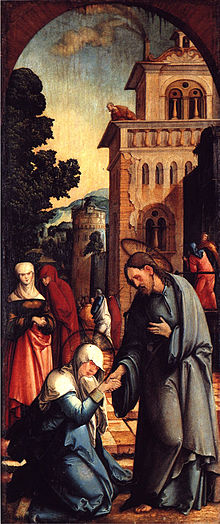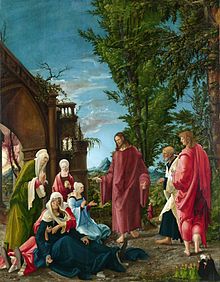Christ taking leave of his Mother

Christ taking leave of his Mother is a subject in
After
Subject matter

The subject does not illustrate any Biblical passage, but derives from one of the
Awareness of the subject was further spread by prints, by Albrecht Dürer in his very popular woodcut series the on the Life of the Virgin (ca. 1505),[8] and again in his woodcut Passion series (1509), and also by Lucas van Leyden. As was by then often the case, many provincial painters used the compositions of the prints directly as a basis for their paintings, for example a version from his eponymous altarpiece by the Nuremberg painter known as the "Master of the Schwabach Altarpiece"(1506, Compton Verney House), who uses his fellow-townsman Dürer.[9]
The first third of the 16th century was the period of peak popularity for the subject;
One of the earliest of the few Italian depictions, an early
of 1595 is something of an outlier.Gallery
-
Correggio, probably before 1514, London, with John the Evangelist and (?) Mary Magdalene.
-
Bernhard Strigel, 1520, Berlin. Saint Peter heads the disciples waiting for Christ.
-
Stained glass window by Quaker City Glass Company, 1912 at St. Matthew's German Evangelical Lutheran Church in Charleston, SC.
See also
- Life of Jesus in the New Testament
- Roman Catholic Marian art
References
- ISBN 0-300-12155-5
- ISBN 1-85709-218-X
- ISBN 1-85709-050-0
- ^ Hofmeister, Wernfried. "Steirische Literatur im Mittelalter | Philipp v. Seitz: Marienleben" (in German). Archived from the original on 2018-09-19. Retrieved 2018-09-19.
- ^ Langmuir, pp. 102-3.
- ^ Philadelphia Campin image This derives from Byzantine images, according to Hand, Metzer & Spronk op & page cit.
- Madonna and Child on the left wing, and a Christ taking leave of his Mother on the right wing. MMA, New York- the other wing of this is in England. See Hand, Metzer & Spronk op & page cit., an exhibition catalogue entry for the Basel work.
- ^ Image Archived July 5, 2009, at the Wayback Machine
- ^ "About Compton Verney". Compton Verney.
- ^ Most of the works mentioned here date very close to 1520.
- ^ "National Gallery". nationalgallery.org.uk. Archived from the original on 2009-05-07. Retrieved 2008-03-05.
- ^ "National Gallery". nationalgallery.org.uk. Archived from the original on 2009-05-07. Retrieved 2008-03-05.
- ISBN 1-85709-218-X
- ISBN 0-947645-22-5





